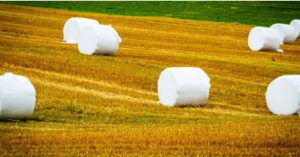Getting the correct net wrap size is critical to protect your bales during storage and transportation. It will help reduce costly damage and the need for additional repairs and replacements. For more net wrap sizes, check this out.
 Generally, it is recommended that 3 – 4 wraps of netwrap should be used for hay bales and 5 – 6 wraps of netwrap for straw bales. However, this varies depending on crop conditions, machinery and baling practices. Ensure you select the correct width size to match your round baling machinery, as most machines will require a specific net wrap width size.
Generally, it is recommended that 3 – 4 wraps of netwrap should be used for hay bales and 5 – 6 wraps of netwrap for straw bales. However, this varies depending on crop conditions, machinery and baling practices. Ensure you select the correct width size to match your round baling machinery, as most machines will require a specific net wrap width size.
1.23m
Tight feed bales that withstand storage and transportation require exceptionally high breaking strength from the netwrap. Piippo’s multi-year product development, production skills and international cooperation network have resulted in the extra-strong Hybrid NG netwrap.
1.25m
The strength, precisely the tensile strength, of the baler netwrap is crucial for ensuring secure bale binding operations. Durable materials like high-density polyethylene (HDPE) deliver a balanced blend of rigidity and impact resistance, resulting in solid netwrap that can withstand various conditions.
Other quality-assurance features, such as guaranteed length and end-of-roll markings, contribute to efficient, productive baling operations. Learn more about these factors to find the best netwrap for your process.
1.28m
The strength, particularly the tensile strength, of the baler netwrap determines its ability to withstand forces involved in bale formation, handling, and transportation. A high tensile strength ensures secure bale binding and reduces the risk of breakage. Durable materials like HDPE are often used to enhance the tensile strength of netwrap. For more net wrap sizes, check this out.
Other critical considerations for selecting baler netwrap include UV protection and compatibility with your baling equipment. Explore reliable warranty coverage and services offered by suppliers to ensure your netwrap is a good investment.
It retards nutrient loss and leaf loss, improves bale density, makes bales easier to move and store, and reduces spoilage. It also helps with moisture shedding. A red strip is near the end of the roll to warn when the wrap is close to running out.
1.35m
Recent attempts to extend netwrap around the edge of a cylindrical bale have been difficult. These efforts have involved a variable-sized baling chamber with guide plates to compress the ends of the bale. This approach distorts the appearance and shape of the bale and can be challenging to achieve mechanically.
The present invention relates to a netwrap delivery assembly 50 disposed on the baler and controlled by an actuator 70. The delivery assembly 50 includes a pair of arms 51 positioned outside the baling chamber sidewalls. The netwrap delivery assembly consists of a roller 42, an idler roll 43, and a couple of netwrap spreader roll 52.
1.40m
The strength, specifically tensile strength, of the baler netwrap defines its ability to hold together during the forces involved in bale formation, handling, and transportation. Durable materials such as High-Density Polyethylene (HDPE) deliver a balance of rigidity and impact strength for secure wrapping without tearing or breakage. For more net wrap sizes, check this out.
Quality assurance features like guaranteed length and end-of-roll marking help optimize your baling operations. Explore these and other crucial factors when selecting a baler netwrap.
1.45m
Vermeer netwrap keeps your bales tighter and denser than twine, reducing hay loss and keeping oxygen out. It also allows you to make bales faster because only one to three turns are required when using net wrap versus eight with twine.
Ensure you select the correct width size to match your round baling machinery, as most machines will require a specific net wrap width size.
The best way to avoid hay bale problems like collapse and wrap failure is to use the correct number of netwrap layers. A minimum of seven wraps should be applied on all sides of a bale. It provides a good level of bale protection, sufficient to withstand the rigours of handling and transporting. It also allows the bale to retain more dry matter in storage.